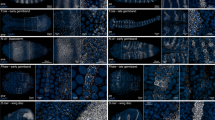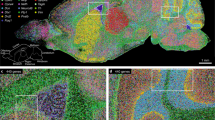Abstract
Here we describe a fluorescence in situ hybridization protocol that allows for the detection of two mRNA species in fresh frozen brain tissue sections. This protocol entails the simultaneous and specific hybridization of hapten-labeled riboprobes to complementary mRNAs of interest, followed by probe detection via immunohistochemical procedures and peroxidase-mediated precipitation of tyramide-linked fluorophores. In this protocol we describe riboprobes labeled with digoxigenin and biotin, though the steps can be adapted to labeling with other haptens. We have used this approach to establish the neurochemical identity of sensory-driven neurons and the co-induction of experience-regulated genes in the songbird brain. However, this procedure can be used to detect virtually any combination of two mRNA populations at single-cell resolution in the brain, and possibly other tissues. Required controls, representative results and troubleshooting of important steps of this procedure are presented. After tissue sections are obtained, the total length of the procedure is 2–3 d.
This is a preview of subscription content, access via your institution
Access options
Subscribe to this journal
Receive 12 print issues and online access
$259.00 per year
only $21.58 per issue
Buy this article
- Purchase on Springer Link
- Instant access to full article PDF
Prices may be subject to local taxes which are calculated during checkout



Similar content being viewed by others
References
Pinaud, R. Critical calcium-regulated biochemical and gene expression programs involved in experience-dependent plasticity. in Plasticity in the Visual System: From Genes to Circuits (eds. Pinaud, R., Tremere, L.A. & De Weerd, P.) 153–180 (Springer-Verlag, New York, 2005).
Pinaud, R. & Tremere, L.A. Immediate Early Genes in Sensory Processing, Cognitive Performance and Neurological Disorders (Springer-Verlag, New York, 2006).
Pinaud, R., Tremere, L.A. & De Weerd, P. Plasticity in the Visual System: From Genes to Circuits (Springer-Verlag, New York, 2005).
Hatten, M.E. & Heintz, N. Large-scale genomic approaches to brain development and circuitry. Annu. Rev. Neurosci. 28, 89–108 (2005).
Gustincich, S. et al. The complexity of the mammalian transcriptome. J. Physiol. 575, 321–332 (2006).
Hofmann, H.A. Functional genomics of neural and behavioral plasticity. J. Neurobiol. 54, 272–282 (2003).
Pascual-Leone, A., Amedi, A., Fregni, F. & Merabet, L.B. The plastic human brain cortex. Annu. Rev. Neurosci. 28, 377–401 (2005).
Hensch, T.K. Critical period regulation. Annu. Rev. Neurosci. 27, 549–579 (2004).
Buonomano, D.V. & Merzenich, M.M. Cortical plasticity: from synapses to maps. Annu. Rev. Neurosci. 21, 149–186 (1998).
Yao, H. & Dan, Y. Synaptic learning rules, cortical circuits, and visual function. Neuroscientist 11, 206–216 (2005).
Chklovskii, D.B., Mel, B.W. & Svoboda, K. Cortical rewiring and information storage. Nature 431, 782–788 (2004).
Sanes, J.N. & Donoghue, J.P. Plasticity and primary motor cortex. Annu. Rev. Neurosci. 23, 393–415 (2000).
Weinberger, N.M. Dynamic regulation of receptive fields and maps in the adult sensory cortex. Annu. Rev. Neurosci. 18, 129–158 (1995).
Singh, S.M., Treadwell, J., Kleiber, M.L., Harrison, M. & Uddin, R.K. Analysis of behavior using genetical genomics in mice as a model: from alcohol preferences to gene expression differences. Genome 50, 877–897 (2007).
Chambers, D. & Fishell, G. Functional genomics of early cortex patterning. Genome Biol. 7, 202 (2006).
Clayton, D.F. Songbird genomics: methods, mechanisms, opportunities, and pitfalls. Ann. NY Acad. Sci. 1016, 45–60 (2004).
Tribl, F. et al. Proteomics of the human brain: sub-proteomes might hold the key to handle brain complexity. J. Neural. Transm. 113, 1041–1054 (2006).
Pinaud, R., Osorio, C., Alzate, O. & Jarvis, E.D. Profiling of experience-regulated proteins in the songbird auditory forebrain using quantitative proteomics. Eur. J. Neurosci. 27, 1409–1422 (2008).
Kee, N., Teixeira, C.M., Wang, A.H. & Frankland, P.W. Imaging activation of adult-generated granule cells in spatial memory. Nat. Protoc. 2, 3033–3044 (2007).
Guzowski, J.F. et al. Mapping behaviorally relevant neural circuits with immediate-early gene expression. Curr. Opin. Neurobiol. 15, 599–606 (2005).
Terleph, T.A. & Tremere, L.A. The use of immediate early genes as mapping tools for neuronal activation: concepts and methods. in Immediate Early Genes in Sensory Processing, Cognitive Performance and Neurological Disorders (eds. Pinaud, R. & Tremere, L.A.) 1–10 (Springer-Verlag, New York, 2006).
Guzowski, J.F. Immediate early genes and the mapping of environmental representations in hippocampal networks. in Immediate Early Genes in Sensory Processing, Cognitive Performance and Neurological Disorders (eds. Pinaud, R. & Tremere, L.A.) 159–176 (Springer-Verlag, New York, 2006).
Owens, N.C., Hess, F.M. & Badoer, E. In situ hybridization using riboprobes on free-floating brain sections. Methods Mol. Biol. 326, 163–171 (2006).
Henderson, Z. In Situ Hybridization Techniques for the Brain (John Wiley & Sons, New York, 1996).
Schneider Gasser, E.M. et al. Immunofluorescence in brain sections: simultaneous detection of presynaptic and postsynaptic proteins in identified neurons. Nat. Protoc. 1, 1887–1897 (2006).
Glynn, M.W. & McAllister, A.K. Immunocytochemistry and quantification of protein colocalization in cultured neurons. Nat. Protoc. 1, 1287–1296 (2006).
Wisden, W. & Morris, B.J. In Situ Hybridization Protocols for the Brain (Academic Press Inc., San Diego, 1994).
Zaidi, A.U., Enomoto, H., Milbrandt, J. & Roth, K.A. Dual fluorescent in situ hybridization and immunohistochemical detection with tyramide signal amplification. J. Histochem. Cytochem. 48, 1369–1375 (2000).
Guzowski, J.F., McNaughton, B.L., Barnes, C.A. & Worley, P.F. Environment-specific expression of the immediate-early gene Arc in hippocampal neuronal ensembles. Nat. Neurosci. 2, 1120–1124 (1999).
Breininger, J.F. & Baskin, D.G. Fluorescence in situ hybridization of scarce leptin receptor mRNA using the enzyme-labeled fluorescent substrate method and tyramide signal amplification. J. Histochem. Cytochem. 48, 1593–1599 (2000).
Velho, T.A., Pinaud, R., Rodrigues, P.V. & Mello, C.V. Co-induction of activity-dependent genes in songbirds. Eur. J. Neurosci. 22, 1667–1678 (2005).
Pinaud, R. et al. GABAergic neurons participate in the brain's response to birdsong auditory stimulation. Eur. J. Neurosci. 20, 1318–1330 (2004).
Pinaud, R., Penner, M.R., Robertson, H.A. & Currie, R.W. Upregulation of the immediate early gene arc in the brains of rats exposed to environmental enrichment: implications for molecular plasticity. Brain Res. Mol. Brain Res. 91, 50–56 (2001).
Pinaud, R. et al. Complexity of sensory environment drives the expression of candidate-plasticity gene, nerve growth factor induced-A. Neuroscience 112, 573–582 (2002).
Pinaud, R., Saldanha, C.J., Wynne, R.D., Lovell, P.V. & Mello, C.V. The excitatory thalamo-'cortical' projection within the song control system of zebra finches is formed by calbindin-expressing neurons. J. Comp. Neurol. 504, 601–618 (2007).
Mello, C.V., Jarvis, E.D., Denisenko, N. & Rivas, M. Isolation of song-regulated genes in the brain of songbirds. Methods Mol. Biol. 85, 205–217 (1997).
Mello, C.V. & Clayton, D.F. Differential induction of the ZENK gene in the avian forebrain and song control circuit after metrazole-induced depolarization. J. Neurobiol. 26, 145–161 (1995).
Acknowledgements
The work described here was supported by NIH/NIDCD and a start-up package from the University of Rochester to R.P. R.P. would like to dedicate this work to the memory of Manoel Campos Ribeiro.
Author information
Authors and Affiliations
Corresponding author
Rights and permissions
About this article
Cite this article
Pinaud, R., Mello, C., Velho, T. et al. Detection of two mRNA species at single-cell resolution by double-fluorescence in situ hybridization. Nat Protoc 3, 1370–1379 (2008). https://doi.org/10.1038/nprot.2008.115
Published:
Issue Date:
DOI: https://doi.org/10.1038/nprot.2008.115
This article is cited by
-
Variant Ionotropic Receptors in the Malaria Vector Mosquito Anopheles gambiae Tuned to Amines and Carboxylic Acids
Scientific Reports (2017)
-
KIFC1 and myosin Va: two motors for acrosomal biogenesis and nuclear shaping during spermiogenesis of Portunus trituberculatus
Cell and Tissue Research (2017)
-
“Nanofiltration” Enabled by Super-Absorbent Polymer Beads for Concentrating Microorganisms in Water Samples
Scientific Reports (2016)
-
Skp2 regulates non-small cell lung cancer cell growth by Meg3 and miR-3163
Tumor Biology (2016)
-
Direct metabolomics for plant cells by live single-cell mass spectrometry
Nature Protocols (2015)
Comments
By submitting a comment you agree to abide by our Terms and Community Guidelines. If you find something abusive or that does not comply with our terms or guidelines please flag it as inappropriate.



